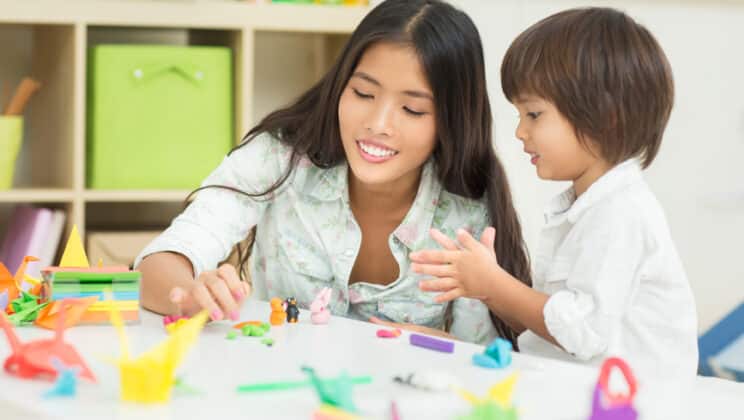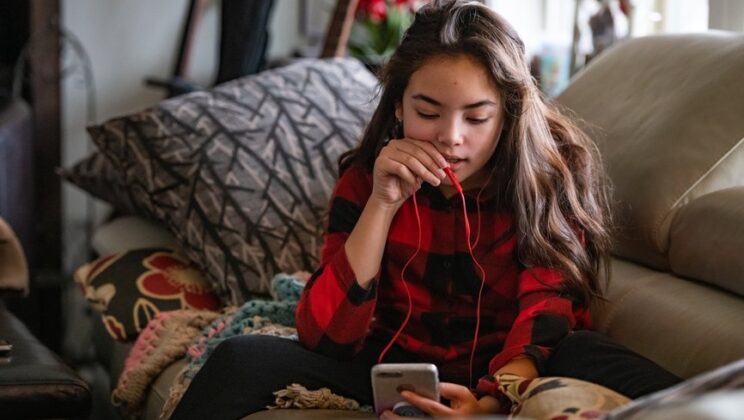‘What We Don’t Heal, We Repeat:’ Creating Connection with Your Teens
December 15, 2020
Growing up, the winter holiday season between Christmas and the new year was always the longest period of time I spent with my family. My father worked abroad and my mother travelled home to Taiwan often for family matters; even when we were living in the same house, my mother and I rarely spoke. But once a year, we’d all put down our work and gather during my school’s winter break. That time of togetherness always had a special weight in my heart, as if I had to fit all the love and connection I craved from my family throughout the year into those two weeks.
The high expectations always set me up for disappointment.
I wanted to celebrate the way I saw it on TV: With big family gatherings, Christmas tree shopping, board games, and making gingerbread houses. But each year, we inevitably would set up our plastic tree, eat hot pot instead of Christmas ham, and fall asleep before the New Year count down. After all, these holidays had little to do with the festivals we grew up celebrating in Taiwan.
Beyond going through the motions of celebrating, each member of my family also did their best to keep a familiar, tense silence at bay. Everything had to be executed with precision. The Christmas tree needed to be decorated without dropping a single ornament. No ingredient could be substituted, even if it meant driving an extra hour to search three more stores. Dinner had to be ready by 6:15 p.m. sharp and the table had to be filled with perfectly cooked dishes (because to mess up any dish was a waste of the ingredients). We rarely tried new recipes.
In fact, we rarely tried anything new. We didn’t see each other much, so there was no time for imperfection. And should anyone dare misstep in this delicate dance, a dreaded silence would blanket the night.
Most years, I’d escape the suffocating anxiety of this dance by blaming homework and retreating to my bedroom. And then we’d be back to normal: No one had to speak and acknowledge the fact that we were all at some level avoiding each other because we were unsure how to connect beyond pleasantries.
I know all this is not uncommon, especially in immigrant families. Earlier this year, I wrote in the New York Times about how intergenerational trauma impacted my parents’ parenting style and my own struggle with depression and anxiety as a teen. I received an outpouring of love and personal stories from friends and strangers alike. The common thread in all of these stories was that what we don’t heal, we repeat.
As a teen and young adult, I carried this uneasiness around connecting with others into my friendships and romantic relationships. I obsessed about creating meaningful connections by meticulously planning gatherings, game nights, and rituals with my friends and partners, all the while feeling terrified that it would all fall apart. I felt guilty and sad when a friendship or relationship would fail despite my best efforts, and then I felt ashamed for feeling that way.
I always wondered why connection was so important to me until I learned that it’s an entirely normal and universal human need. Social connectedness helps us thrive and is a major protective factor against anxiety and depression – both of which I’ve struggled with since adolescence. I understood then that learning to connect was a theme for many of my behaviors and motivations since childhood. It was also a key to my family’s healing.
So what is connection?
Merriam-Webster defines connection as "a relation of personal intimacy such as family ties." Psychology literature defines connection as a sense that you belong to a group and generally feel close to other people. Researchers emphasize that as humans, our brains are wired for survival by reaching out and connecting with others. In other words, most people are born with an innate ability to connect. For me, connection is a state of safety and acceptance that allows me to intimately know another person and be known by them. We all hide so much of ourselves behind what we think another person wants from us, but when we’re truly connected, I believe we can come as we are: Goofy, thoughtful, and contradictory all at once.
My family and I are still learning to nurture our connection. Here’s what’s worked for us so far:
1. Build a shared reality and common vocabulary.
It sounds simple, but we each have our own realities and none are necessarily “right”. Can you describe a past misunderstanding or experience in a way that everyone else in the family can accept? This requires finding neutral, common language that helps you establish a shared reality. Common vocabulary can help: What does it mean for each of you to feel connected? What does it mean for each of you to feel safe, happy, and supported? What do boundaries mean for your family? And what are the safe words to de-escalate conflict in your family? It’s also helpful to keep in mind that behaviors can be a type of vocabulary. In my family, for example, we had to establish a shared understanding of what crying means (is something terribly wrong, or are you just expressing yourself?).
2. Get to know each others’ preferences
Reflect and share: What is a specific moment you felt loved by someone in the family? What did they do (or not do)? What makes you feel connected? My family started with an exercise where we guessed each others’ love languages, then had each person reveal their preference. It’s funny and surprising how often you can still be wrong about people you’ve known for decades. For my risk-averse family, making these mistakes together gave us a chance to bond and take greater risks together. Once we learned everyone’s preferences, we discussed ways to balance our time together to include more of what works for each of us.
3. Share vulnerable, difficult memories
Past experiences can shape a lot of our present beliefs and motivations. What memories feel significant for your family members? If you were a part of that memory, can you listen and accept their experience of it? Get curious and ask open-ended questions like, “Does that still impact you today?” or “What does it feel like to share this now?”
Sharing past memories can be especially difficult for parents and relatives who don’t believe their childhood experiences influence the present. You can start the conversation by sharing a memory of your own, or suggesting a conversation card game (such as We’re Not Really Strangers, The Skin Deep, or Parents are Human). For my family, it’s been especially helpful to give a heads up like, “I’d love to talk about ______ next time we’re together.” It sounds awkward, but helps everyone think about the topic independently and prepare emotionally for the conversation.
4. Have family meetings
Even if it seems overly formal, it’s been helpful for my family to have regular touch points as we learn to connect more deeply with each other. One thing we noticed is that we knew so little about each other’s lives to begin with that we would spend a lot of our time together just sharing life updates instead of diving into deeper conversation. To remedy this, we now have regularly scheduled family meetings where we can share personal updates and any observations about our family dynamics worth discussing. This has enabled us to go into deeper levels of conversation and get to know each others’ motivations, desires, hopes, and fears.
These suggestions may sound simple on paper, but they took over a decade of healing and practice from everyone in my family to implement. Outside of my family, I still work on what I learned from therapy and research over the years. I’ve realized that only when I can self-soothe, reframe my black-and-white thinking, and protect my own boundaries can I help families — including my own— change and heal from their intergenerational patterns.
This holiday season, I’m looking forward to cherishing the connection my family has learned to nurture over the past few years. I think this year I’ll finally bring home a board game for us to try.
CONTACT US
If you want help connecting with a therapist, Lyra can assist you. You can get started today if Lyra is offered by your employer. Sign up here.
For employers who want to learn more about how Lyra’s enhanced EAP addresses network adequacy and quality issues, download our whitepaper on quality or get in touch.
And check in frequently here or follow us on Facebook, LinkedIn, and Twitter for more insights into supporting employees’ mental health.
DISCLAIMER
The content of this blog is not intended to be a substitute for professional medical advice, diagnosis, or treatment.
ABOUT THE AUTHOR:
Grace Chiang is the founder of Cherish, a social venture that aims to help parents build healthy relationships with their teens.
Explore additional blogs

Youth mental health
Building a Village for Family Mental Health Care

Youth mental health
4 Things You Should Know About Adolescent Mental Health

COVID